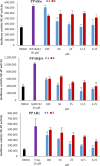Two antibacterial and PPARα/γ-agonistic unsaturated keto fatty acids from a coral-associated actinomycete of the genus Micrococcus
- PMID: 32256847
- PMCID: PMC7082699
- DOI: 10.3762/bjoc.16.29
Two antibacterial and PPARα/γ-agonistic unsaturated keto fatty acids from a coral-associated actinomycete of the genus Micrococcus
Abstract
A pair of geometrically isomeric unsaturated keto fatty acids, (6E,8Z)- and (6E,8E)-5-oxo-6,8-tetradecadienoic acids (1 and 2), were isolated from the culture broth of an actinomycete of the genus Micrococcus, which was associated with a stony coral, Catalaphyllia sp. Their chemical structures were elucidated by spectroscopic analysis including NMR and MS, with special assistance of spin system simulation studies for the assignment of an E geometry at C8 in 2. As metabolites of microbes, compounds 1 and 2 are unprecedented in terms of bearing a 2,4-dienone system. Both 1 and 2 showed antibacterial activity against the plant pathogen Rhizobium radiobacter and the fish pathogen Tenacibaculum maritimum, with a contrasting preference that 1 is more effective to the former strain while 2 is so to the latter. In addition, compounds 1 and 2 displayed agonistic activity against peroxisome proliferator-activated receptors (PPARs) with an isoform specificity towards PPARα and PPARγ.
Keywords: Micrococcus; PPAR; antibacterial; coral; keto fatty acid.
Copyright © 2020, Sharma et al.; licensee Beilstein-Institut.
Figures
Similar articles
-
Two Isomeric C16 Oxo-Fatty Acids from the Diatom Chaetoceros karianus Show Dual Agonist Activity towards Human Peroxisome Proliferator-Activated Receptors (PPARs) α/γ.Mar Drugs. 2017 May 25;15(6):148. doi: 10.3390/md15060148. Mar Drugs. 2017. PMID: 28587091 Free PMC article.
-
Role of peroxisome proliferator-activated receptors alpha and gamma in gastric ulcer: An overview of experimental evidences.World J Gastrointest Pharmacol Ther. 2015 Nov 6;6(4):120-6. doi: 10.4292/wjgpt.v6.i4.120. World J Gastrointest Pharmacol Ther. 2015. PMID: 26558146 Free PMC article.
-
Two new 2-alkylquinolones, inhibitory to the fish skin ulcer pathogen Tenacibaculum maritimum, produced by a rhizobacterium of the genus Burkholderia sp.Beilstein J Org Chem. 2018 Jun 14;14:1446-1451. doi: 10.3762/bjoc.14.122. eCollection 2018. Beilstein J Org Chem. 2018. PMID: 29977408 Free PMC article.
-
Peroxisome proliferator-activated receptors and the regulation of mammalian lipid metabolism.Biochem Soc Trans. 2002 Nov;30(Pt 6):1086-90. doi: 10.1042/bst0301086. Biochem Soc Trans. 2002. PMID: 12440979 Review.
-
Peroxisome proliferator-activated receptors and the control of inflammation.Curr Drug Targets Inflamm Allergy. 2002 Sep;1(3):243-8. doi: 10.2174/1568010023344616. Curr Drug Targets Inflamm Allergy. 2002. PMID: 14561188 Review.
Cited by
-
Microbispofurans A-C, plant growth-promoting furancarboxylic acids from plant root-derived Microbispora sp.J Antibiot (Tokyo). 2023 Jul;76(7):392-396. doi: 10.1038/s41429-023-00614-1. Epub 2023 Apr 4. J Antibiot (Tokyo). 2023. PMID: 37016013
-
Iseoic acids and bisiseoate: three new naphthohydroquinone/naphthoquinone-class metabolites from a coral-derived Streptomyces.J Antibiot (Tokyo). 2023 Oct;76(10):618-622. doi: 10.1038/s41429-023-00644-9. Epub 2023 Jul 11. J Antibiot (Tokyo). 2023. PMID: 37433891
-
Phenolic and Iridoid Glycosides from Leonurus cardiaca L. and Their Effects on the α, δ, and γ Subtypes of the PPAR System-Including the Discovery of the Novel Phenylethanoid Cardiaphenyloside A and the Most Active 7-Chloro-6-desoxy-harpagide.Molecules. 2025 Jan 20;30(2):419. doi: 10.3390/molecules30020419. Molecules. 2025. PMID: 39860288 Free PMC article.
-
A cyclopeptide and three oligomycin-class polyketides produced by an underexplored actinomycete of the genus Pseudosporangium.Beilstein J Org Chem. 2020 May 25;16:1100-1110. doi: 10.3762/bjoc.16.97. eCollection 2020. Beilstein J Org Chem. 2020. PMID: 32550925 Free PMC article.
-
Mini review: antimicrobial compounds produced by bacteria associated with marine invertebrates.Folia Microbiol (Praha). 2025 Apr;70(2):271-292. doi: 10.1007/s12223-024-01209-5. Epub 2024 Oct 24. Folia Microbiol (Praha). 2025. PMID: 39446239 Review.
References
-
- Brinkmann C M, Marker A, Kurtböke D I. Diversity. 2017;9:No. 40. doi: 10.3390/d9040040. - DOI
LinkOut - more resources
Full Text Sources
Research Materials





